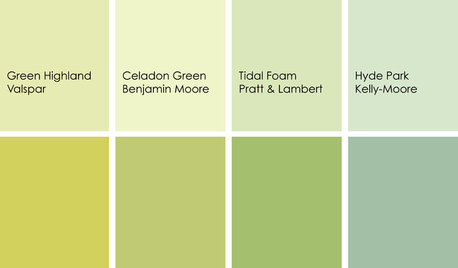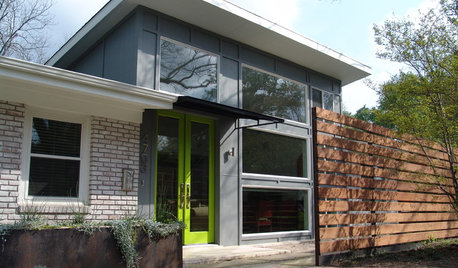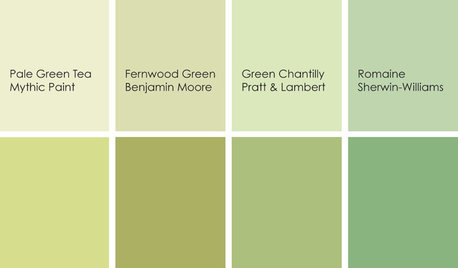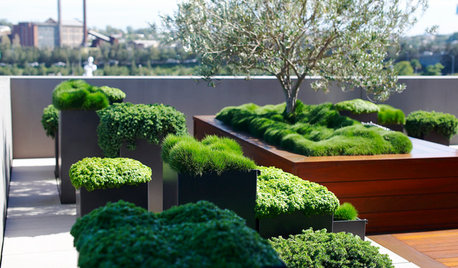when green turns brown
tom_n_6bzone
16 years ago
Related Stories

GARDENING GUIDESGot Frost-Damaged Plants? How It Happens, and When and How to Prune
Crispy brown leaves are a sure sign that Jack Frost has been to your neighborhood
Full Story
CURB APPEALWhen to Paint Your House Brown
Nature loves brown, from rich soil to sunlit sand, and so do home exteriors with a traditional or Craftsman bent
Full Story
TROPICAL STYLEEasy Decorating: Turn Over a New, Tropical Leaf
Toss a palm frond in a vase or gather a whole bouquet — fresh or preserved tropical leaves bring on the exotic with almost no effort
Full Story
DINING ROOMSColor Feast: When to Use Green in the Dining Room
Squeeze a little lime into the space where you dine — green walls, chairs or accessories can be delicious if you do them right
Full Story
COLORBathed in Color: When to Use Green in the Bath
Splash some spring-conjuring green paint, tiles or accessories around your bathroom for natural appeal
Full Story
FRONT DOOR COLORSFront and Center Color: When to Paint Your Door Green
Fresh, fun and a pleasant surprise on a front door, green in subtle to strong shades brings energy to home exteriors
Full Story
KITCHEN DESIGNCooking With Color: When to Use Green in the Kitchen
Consider a taste of Romaine or Pale Green Tea to make your kitchen walls or cabinets the freshest ones around
Full Story
LANDSCAPE DESIGNSee How to Turn a Small Outdoor Room Into a Peaceful Retreat
Really, that neglected terrace or courtyard can become the garden of your dreams
Full Story
STORAGEStorage Surprise: Turn Colorful Tool Cabinets Into Fun Furniture
Reimagine your handy chests as nightstands, bar carts and kitchen storage for a bright interior alternative
Full Story
HOUZZ TOURSHouzz Tour: Schoolhouse-Turned-Home in Chicago
A family of seven settles into a dream modern-industrial home that reflects both their green philosophy and their fun, casual lifestyle
Full StoryMore Discussions







diggity_ma
mmqchdygg
Related Professionals
Havre de Grace Landscape Architects & Landscape Designers · Hyattsville Landscape Architects & Landscape Designers · Stoughton Landscape Contractors · Woburn Landscape Contractors · Dinuba Landscape Contractors · Fruit Heights Landscape Contractors · North Chicago Landscape Contractors · Salem Landscape Contractors · Markham Landscape Contractors · Elkridge Decks, Patios & Outdoor Enclosures · Arbutus Decks, Patios & Outdoor Enclosures · Ashland Decks, Patios & Outdoor Enclosures · Diamond Bar Decks, Patios & Outdoor Enclosures · Lacey Decks, Patios & Outdoor Enclosures · Reisterstown Decks, Patios & Outdoor Enclosurestom_n_6bzoneOriginal Author
tom_n_6bzoneOriginal Author
dchall_san_antonio
Kimmsr
digdirt2
tom_n_6bzoneOriginal Author
digdirt2
dchall_san_antonio
Kimmsr
mmqchdygg
dorisl
bpgreen
mmqchdygg
diggity_ma
albert_135 39.17°N 119.76°W 4695ft.
mmqchdygg
bpgreen
dorisl
bpgreen
diggity_ma
tsugajunkie z5 SE WI ♱
digdirt2
tom_n_6bzoneOriginal Author
tom_n_6bzoneOriginal Author
tom_n_6bzoneOriginal Author
tom_n_6bzoneOriginal Author
diggity_ma
digdirt2
tom_n_6bzoneOriginal Author
digdirt2
tom_n_6bzoneOriginal Author
diggity_ma